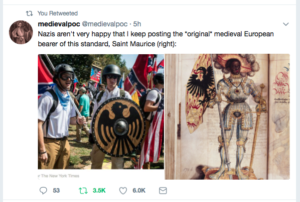Note, evening 16 Sept: this post went up before the 15 Sept e-incident of Chicago medievalist Rachel Fulton Brown engaging in ad hominem insults of Vassar medievalist Dorothy Kim; the post’s spirit is most definitely with Kim’s arguments about the intersections among medieval studies, white supremacy, and pedagogy. For a solid recounting of the events, see Richard Utz’s blog here
Post, early morning 15 Sept: Like most medievalists, The Massachusetts Medievalist has been thinking about how to address the overt medievalism of the current white supremacist movement in the USA while simultaneously beginning the academic year and trying to finish the summer to-do list.
A number of more energetic bloggers have written in a much more timely manner about about the medievalism on display at the neo-Nazi rally in Charlottesville in August 2017; Paul Sturtevant’s Public Medievalist site provides excellent commentary and links to other resources, and this wonderful Medieval People of Color tweet educating white supremacists about the African origin of one of their favorite symbols is still garnering attention in social media:

My own small contribution was to assign Josephine Livingstone’s “Racism, Medievalism, and the White Supermacists” of Charlottesville for the first day of English Lit I. As at many universities, our English majors take core survey classes in the histories of American and Engish literature; as at many universities, our first term “covers” the medieval through the neoclassical periods. But I felt uncomfortable starting a unit on medieval English literature without addressing the political elephant in the room. Yes, the United States is at a cultural moment when I felt it necessary to explicitly dissassociate myself and my discipline from white nationalist movements.
Teachers refer repeatedly to the need to have “uncomfortable conversations” in the classroom, and boy, was I uncomfortable in a brief discussion of Livingstone’s work and its relevance to our academic coursework. Students had a few contributions, making that section of the class a bit of a “conversation,” but most were reticent. I’m glad that moment happened, however, and hope that it will begin to pave the way for more moments that could be less awkward. Beowulf promises to bring issues of immigration, border crossing, power dynamics, and political alliance into class discussion, illustrating a series of productive connections between an early medieval cultural artifact and our contemporary political discourse.
